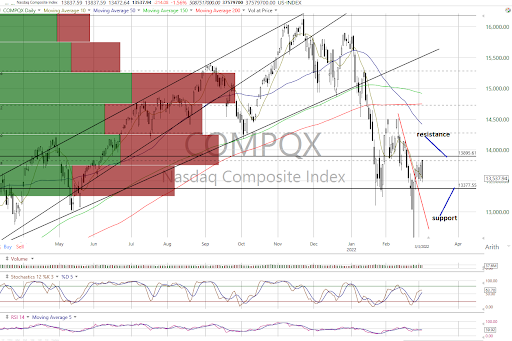Here’s an interesting fact after Thursday’s market downslide: Following the washout trading session on Feb 24, all the major equity indexes, except for the Nasdaq Composite, have been making a series of higher lows that suggest buying demand has been getting more aggressive on each pullback.
Meanwhile, the data are showing a notable increase in bearish sentiment on the Rydex Ratio, which we view as a positive due to its contrarian implications.
So, for now, the charts suggest we remain in neutral patterns with the caveat that extreme bearish sentiment poses a possible upside catalyst should some positive news hit the tape.
On the Charts

Source: Worden
All the major equity indexes closed lower Thursday with negative internals and lower trading volume as all closed near their lows of the session, no support levels were violated.
The S&P 500, DJIA, Nasdaq Composite (see above), Nasdaq 100 and Russell 2000 tested their respective levels at the start of the session but failed to violate.
In fact, we would draw attention to the fact that all the indexes, except the Nasdaq Composite, have been making higher intraday lows after what we view as the washout on Feb. 24. This suggests buyers have been getting more aggressive on each subsequent pullback. While not definitive, we do view it as somewhat encouraging.
Thus, all but the Value Line Arithmetic Index, which is near-term negative, remain in neutral near-term trends.
The cumulative advance/decline lines for the All Exchange, NYSE and nasdaq remain neutral as well.
No stochastic signals of import were generated.
The Data
Data remain generally neutral except for investor sentiment.
The McClellan 1-Day Overbought/Oversold oscillators remain neutral (All Exchange: +15.33 NYSE: +24.84 Nasdaq: +6.87).
The percentage of S&P 500 issues trading above their 50-day moving averages dipped to 33%, staying neutral.
The Open Insider Buy/Sell Ratio is neutral, dipping slightly to 45.5.
The detrended Rydex Ratio (contrarian indicator) however, sank to -1.56. These traders are now heavily leveraged short, adding to the already heavy levels of bearish sentiment.
This week’s AAII Bear/Bull Ratio (contrarian indicator) remained a potentially significant factor for the near term, as well. The AAII reading was 1.98 versus its prior 1.79 and found the crowd near peak levels of fear. As a contrarian indicator, it is potentially a strong positive should any good news hit the tape.
The Investors Intelligence Bear/Bull Ratio (31.0/32.2) (contrary indicator) remains bullish as well.
Market Valuation and Yields
The forward 12-month consensus earnings estimate from Bloomberg for the S&P 500 has increased to $226.04 per share. As such, the S&p’s forward P/E multiple is now 19.3x with the “rule of 20” finding ballpark fair value at 18.2x.
The S&P’s forward earnings yield stands at 5.18%.
The 10-Year Treasury yield closed at 1.84%. We view resistance at 1.92% and support at 1.77%.
Get an email alert each time I write an article for Real Money. Click the “+Follow” next to my byline to this article.
Source: https://realmoney.thestreet.com/markets/all-indexes-close-lower-but-make-higher-lows-15929765?puc=yahoo&cm_ven=YAHOO&yptr=yahoo